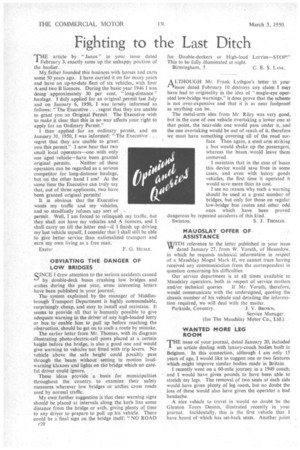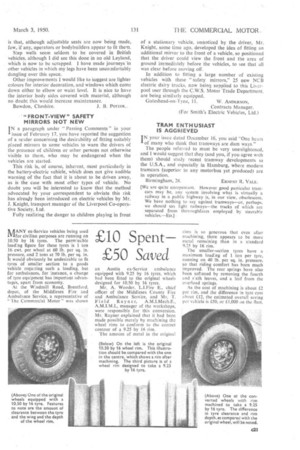Fighting to the Last Ditch
Page 56

Page 57

If you've noticed an error in this article please click here to report it so we can fix it.
THE article by " Janus " in your issue dated I February 3, exactly sums up the unhappy position of the haulier.
My father founded this business with horses and carts some 50 years ago. I have carried it on for many years and have an up-to-date fleet of six vehicles, with four A and two B licences. During the basic year 1946 I was doing approximately 30 per cent. " long-distance " haulage. I duly applied for an original permit last July and an January 6, 1950, I was tersely informed as follows: "The Executive.. . regret that they are unable to grant you an Original Permit. The Executive wish to make it clear that this in no way affects your right to apply for an Ordinary Permit."
I then applied for an ordinary permit, and on January 31, 1950, I was informed: "The Executive . .
regret that they are unable to grant you this permit." I now hear that two small local operators—one with only one aged vehicle—have been granted original permits. Neither of these operators can be regarded as a serious competitor for long-distance haulage, but on the other hand I am! At the same time the Executive can truly say that, out of three applicants, two have been granted original permits!
It is obvious that the Executive wants my traffic and my vehicles, and so steadfastly refuses any sort of • permit. Well, I am forced to relinquish my traffic, but they shall not have my vehicles and A licences, and I shall carry on till the bitter end—if I finish up driving my last vehicle myself, I consider that I shall still be able to give better service than nationalized transport and earn my own living as a free man.
Exeter F. G. HEALE.
OBVIATING THE DANGER OF LOW BRIDGES
SINCE I drew attention to the serious accidents caused by double-deck buses crashing low bridges and arches during the past year, some interesting letters have been published in your journal.
The system explained by the manager of Middlesbrough Transport Department is highly commendable, surprisingly cheap, and easy to install and maintain. It seems to provide all that is humanly possible to give adequate warning to the driver of any high-loaded harry or bus to enable him to pull up before reaching the obstruction, should he get an to such a route by mistake.
The earlier fetter from Mr. Thomas, with its diagram illustrating photo-electric-cell posts placed at a certain height before the bridge, is also a good one and would give warning to vehicles not fitted with trip levers. No vehicle above the safe height could possibly pass through the beam without setting in motion loudwarning klaxons and lights on the bridge which no careful driver could ignore.
These ideas provide a basis for municipalities throughout the country to examine their safety measures wherever low bridges or arches cross roads used by normal traffic.
My own further suggestion is that clear warning signs should be placed at intervals along the kerb line some distance from the bridge or arch, giving plenty of time to any driver to prepare to pull up his vehicle. There could be a final sign on the bridge itself: "NO ROAD c20 for Double-deckers or High-load Lorries—STOP!" This to be fully illuminated at night.
Birmingham, 5 C. E. S. LANE.
LTHOUGH Mr. Frank Lythgoe's letter in your 4—tissue dated February 10 destroys any claim I may have had to originality in the idea of "magic-eye operated low-bridge warnings," it does prove that the scheme is not over-expensive and that it is as near foolproof as anything can be.
The metal-arm idea from Mr. Riley was very good, but in the case of one vehicle overtaking a lower one at that point, the near-side one would pass under it, and the one overtaking would be out of reach of it, therefore we must have something covering all of the road surface. Then again, a steel arm striking a bus would shake up the passengers, whereas the beam _would leave them unmoved.
I maintain that in the case of buses this device would save lives in some cases, and even with heavy goods vehicles, the first time it operated it would save more than its cost.
I see no reason why such a warning should be used at a great number of bridges, but only for those on regular low-bridge bus routes and other odd ones which have been proved dangerous by repeated accidents of this kind.
Swinton. S. J. THOMAS.
MAU DSLAY OFFER OF , ASSISTANCE WITH reference to the letter published in your issue " . dated January 27, from W. Yorath, Of Hounslow, in which he requests technical information in respect of a Maudslay Mogul Mark 11, we cannot trace having received any communication from the correspondent in question concerning his difficulties.
Our service department is at all times available to Maudslay operators, both in respect of service matters and/or technical queries. If Mr. Yorath, therefore, would communicate with the undersigned, quoting the chassis number of his vehicle and detailing the information required, we will deal with the matter.
Pa rkside, Coventry. J. V. BROWN, Service Manager.
(for The Maudslay Motor Co., Ltd.).
WANTED MORE LEG ROOM
fHE issue of your journal, dated January 20; included an article dealing with luxury-coach bodies built in Belgium. In this connection, although I am only 15 years of age, I would like to suggest one or two features which might improve similar bodies made in Britain.
I recently went on a 60-mile journey in a 1949 coach, and I would have given pounds to have been able to stretch my legs. The removal of two seats at each side would have given plenty of leg room, but no doubt the loss of these would also have given the operator a bad headache.
A nice vehicle to travel in would no doubt be the Glenton Tours Dennis, illustrated recently in your journal. Incidentally, this is the 'first vehicle that I have heard of which has set-back seats.: Another point
is that, although adjustable seats are now being made, few, if any, operators or bodybuilders appear to fit them.
Step wells seem seldom to be covered in British vehicles, although I did see this done in an old Leyland, which is now to be scrapped. I have made journeys in other vehicles in which my legs have been uncomfortably dangling over this space.
Other improvements I would like to Suggest are lighter colours for interior decoration, and windows which corns down either to elbow or waist level. It is nice to have the interior body sides covered with material, although no doubt this would increase maintenance.
Bowdon, Cheshire. J. B. PorrEa..
• " FRONT-VIEW" SAFETY MIRRORS NOT NEW IN a paragraph under " Passing Comments" in your
issue of February 17, you have reported the suggestion of a reider concerning the desirability of fitting suitably placed mirrors to some vehicles to warn the drivers of the presence of children or other persons not otherwise visible to them, who may he endangered when the vehicles are started.
This risk is, of course, inherent, most particularly in the battery-electric vehicle, which does not give audible warning of the fact that it is about to be driven away, as is the case with most other types of vehicle. No doubt you will be interested to know that the method advocated by your correspondent to obviate this risk has alreak been introduced on electric vehicles by Mr. J. Knight, transport manager of the Liverpool Co-operative Society, Ltd.
Fully realizing the danger to children playing in front of a stationary vehicle, unnoticed by the driver, Mr. Knight, some time ago, developed the idea of fitting an additional mirror to the front of a vehicle, so positioned that the driver could view the front and the area of ground immediately before the vehicles, to see that all was clear before moving off.
In addition to fitting a large number of existing vehicles with these "safety mirrors," 25 new NCB electric dairy trucks, now being supplied to this Liverpool user through the C.W.S. Motor Trade Department, are being similarly equipped.
Gateshead-on-Tyne, 11. W. ANDERSON, Contracts Manager.
(For Smith's Electric Vehicles, Ltd.)
• TRAM ENTHUSIAST IS AGGRIEVED
your issue dated December 16, you said "One hears of many who think that tramways are dam ways."
The people referred to must be very unenlightened, and I would Suggest that they (and you, if you agree with them) should study recent tramway developments in the U.S.A., and especially in Hamburg, where modern tramcars (superior to any motorbus yet produced) are in operation.
Birmingham, 28. EttislEsT R. VALE.
[We are quite unrepentant. However good particular tramcars may be, any system involving what is virtually a railway in a public highway is, in our view, obsolescent. We have nothing to say against tramways—or, perhaps. we should sav light railways—the tracks of which are separated from thoroughfares employed by steerable vehicles.—ED.]
































































































